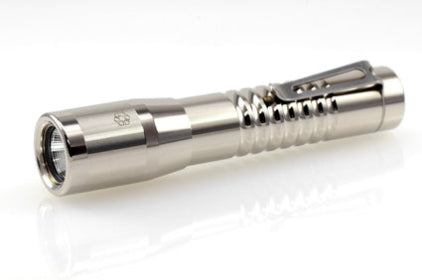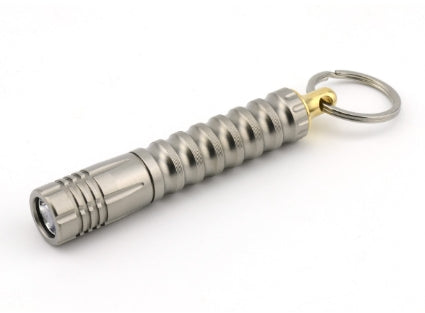Maintenance
In short, keep your threads and o-rings clean and lubricated if you want to maintain optimal performance for as long as possible.
All mechanical systems require regular maintenance to function properly. A flashlight is not exception. We get plenty of warranty claims that are from a lack of maintenance. Save us both some trouble!
Failing to properly maintain your light is like buying a car and never changing the oil. We sell (and recommend) Nano-Oil for lubricating o-rings and threads. It works great and has been extensively tested for o-ring compatibility. It’s the only thing I use on my lights.
Replacement O-rings, lubricants, and tools are available on our "tools & maintenance" page.
> How to clean & maintain threads (flashlights & pens)
Dirty threads can cause premature wear and inhibit the flow of electricity, leading to erratic behavior of the light. You mainly need to worry about the o-rings and threads that are exposed during battery changes.
- Remove o-rings before cleaning to prevent damage. Normally you can just use your fingers, but we also have special tools to make this easier.
- If you are performing regular maintenance you can just use with a dry toothbrush, paper towel, tissue, or Q-tip to wipe down the threads.
- Try to press the swab (or towel) into the threads to get down into the grooves. A toothbrush works great here, but it will also tend to spray dirty stuff around.
- You don’t want to use cleaning fluids unless you must. Regular cleaning should mostly eliminate the need for cleaning fluids.
- Reapply a light coat of oil. A few drops will suffice. Screwing the parts back together will distribute the oil to the internal threads.
- Do not oil internal threads, only apply oil to external threads.
Deep Cleaning (cleaning fluids):
It’s critical that you don’t introduce moisture or oil into the electronics.
- Remove o-rings before cleaning to prevent damage. Normally you can just use your fingers, but we also have special tools to make this easier.
- Start with a dry toothbrush, paper towel, tissue, or Q-tip to remove the bulk of the contamination.
- If your threads are gritty and/or gunked up (from lack of maintenance naughty you) I like to use rubbing alcohol or Windex (something that cuts grease & evaporates quickly).
- Use as little cleaning fluid as possible. This prevents the liquid from migrating into places where it should not.
- Try to press the swab (or towel) into the threads to get down into the grooves. A toothbrush works great here, but it will also tend to spray dirty stuff around.
- Allow parts to dry completely before applying oil.
- Reapply a light coat of oil. A few drops will suffice. Screwing the parts back together will distribute the oil to the internal threads.
- Do not oil internal threads, only apply oil to external threads.
Special Note - Alpha Flashlight Head threads:
- There is a tight fit between the driver mount and the head threads, so it requires a special technique.
- Take a Q-tip and mash the end flat with a pair of pliers. This will allow the Q-tip to fit between the threads and the cylinder that holds the LED driver.
- Run the Q-tip clockwise several turns and then back it out counter clockwise. Repeat with a new tip until most of the black residue stops appearing on the swab.
- If you used cleaning fluid, allow parts to dry completely before applying oil.
- Reapply a light coat of oil. A few drops will suffice. Screwing the parts back together will distribute the oil to the internal threads.
- Do not oil internal threads, only apply oil to external threads.
Window:
- Optics people call that front glassy thingy the light shines through a "window," not a lens. Be careful when you clean it because it has a special anti-reflective coating.
- If you get too aggressive you can damage it. I actually use my hot breath and camera lens papers. Some solvents may damage the coating, so I prefer not to use any.
- Windows are replaceable, and slight scratches/smudges don't have any impact on the function of the light. I'd try not to worry about it.
> How to clean & maintain o-rings
Spare o-rings are included with all Prometheus and Foursevens flashlights. You probably won't need them, but if the main seal ever breaks or tears, you'll have a replacement on hand. You can purchase replacement o-rings on this page.
A dry o-ring will become cracked and/or otherwise damaged during normal use. A lubricated o-ring will not. Damage will compromise water resistance and make your light difficult to operate. A dry o-ring will make your light difficult to operate.
Petroleum based lubricants should not be used because it will damage the o-ring. I recommend the lubricants we well on the site. I use them personally, and they are what we use when building lights. We know they work.
WD-40 is NOT a lubricant, it is a lubricated cleaning solvent...do not use it!
- If your o-ring is dry and not dirty, you can just reapply a couple drops of oil. Enough to get smooth operation, but not so much that it drips everywhere. Excess oil attracts dirt…that you’ll have to clean later.
- For a full cleaning, simply remove the o-ring and clean as needed, being careful not to rip the o-ring with excessive force.
- An o-ring that is visibly damaged should be replaced (cracked or torn). An o-ring does NOT need to be replaced unless it is damaged.
- Reapply a light coat of oil. A few drops will suffice.
- Reinstall the o-ring making sure it is not twisted. A twisted o-ring does not seal well and will accelerate damage.




